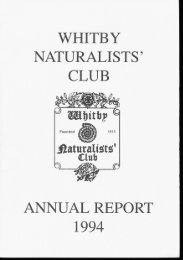2005 - Whitby Naturalists
2005 - Whitby Naturalists
2005 - Whitby Naturalists
You also want an ePaper? Increase the reach of your titles
YUMPU automatically turns print PDFs into web optimized ePapers that Google loves.
The researchers fear that ecosystems afe fragmenting with predafor<br />
species becoming separated from their prey as the smaller prey species<br />
with their shorter life-cycles move north more quickly than the larger,<br />
slower -growing predators.<br />
It rnay be thar species not m()ving tlorth are able to deal with the<br />
changes in temperature and acidity, which infornied t*servers almost<br />
universally considcr to bc the result of hurnan activi.flr. The less<br />
optinristic possibiliry is that their immobllity is the result of their l-raving<br />
highly specialised habirat rcquirements which have not yet been<br />
discovcred by science, and which are not ft;u1d further north, so that<br />
as climate change continues they will become exlinct'<br />
Some workers are worried that if trends continue, by 2050 commerciai<br />
species such as bltre whiring and redfish will have gone completely,<br />
tiiough thcy may be replaced by bib and other species found at present<br />
in more southerly waters. Cr:rtainly some exotic catches are already<br />
being rnade like the rainbow wrasse caught this year on the Bsscx coast-<br />
Forms that are usualiy found off the Cornish coast such as pilchard and<br />
sea hass are appcaring in larger numbers in the North Sea. The<br />
numters of scluid now in our waters is bccoming unreal according to a<br />
Nortl-rumberland fisherman quotecl in The Guardian.<br />
It is r,ot just fish thar are showing change. The Intemational Council<br />
for the Exploration of the Sea (ICES) report that plankton populations<br />
arc also affected. Up to the 1970s the phytoplankton had a pattem o{<br />
spring and autumn peaks in numbers ("blooms"). Front thc 80s these<br />
blooms havc merged into a more continuous production in numbers-<br />
This has led to gleater amounts of these algae treing present in recent<br />
years with the proportion of diatoms decreasing while that of dinoflag'<br />
ellates has increased, thereby provicling more food at the base of the<br />
food wcb. Populations of planktoni.c crustacea too are changing. There<br />
has been a huge drop in rhe numbers o{Caldnus finmarchiclttsr one of the<br />
most imnortant food sources for commerciallv valuable fish' At thc




